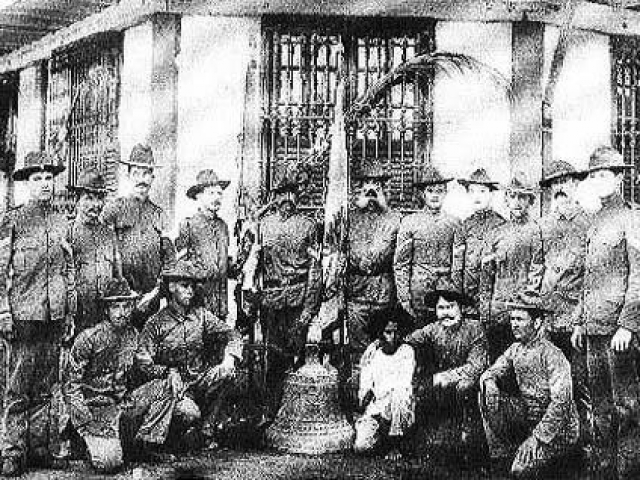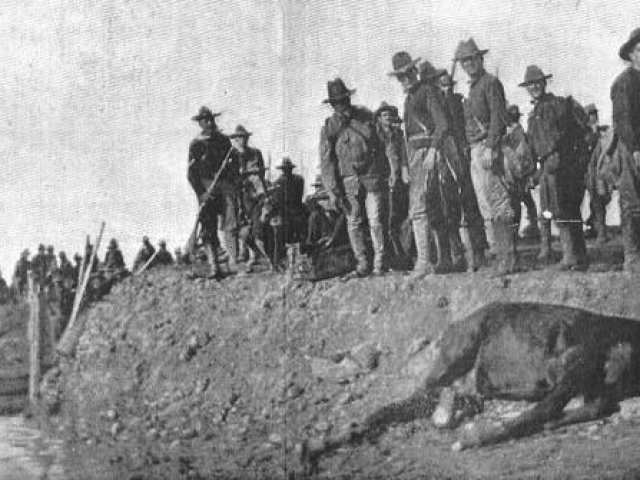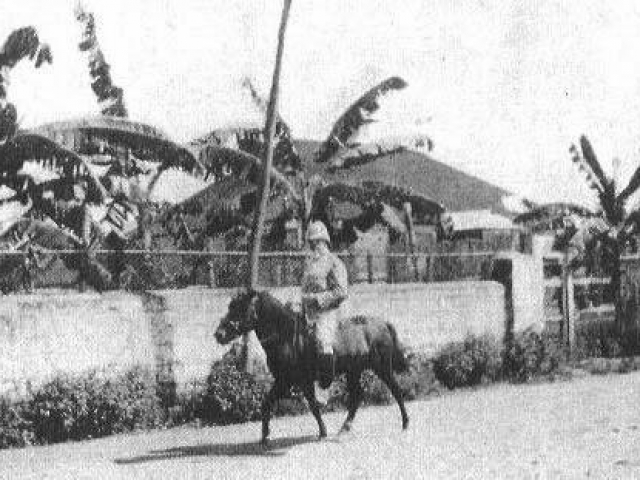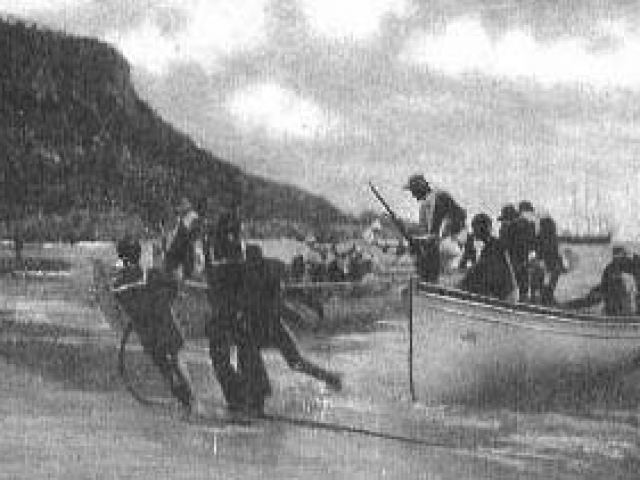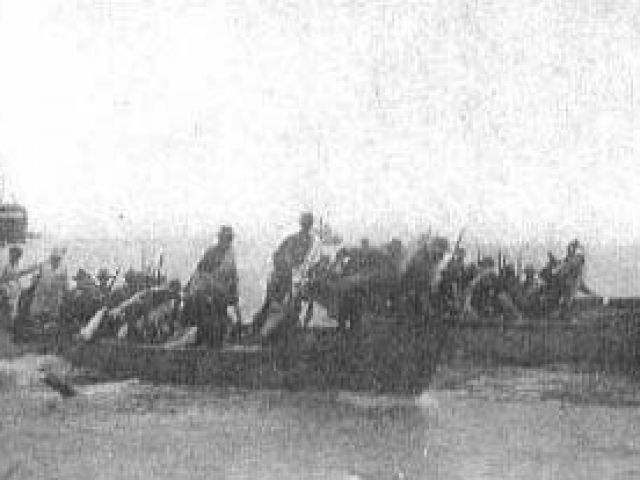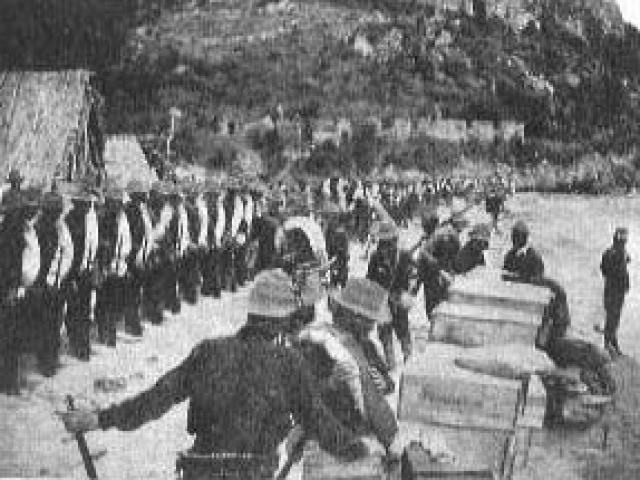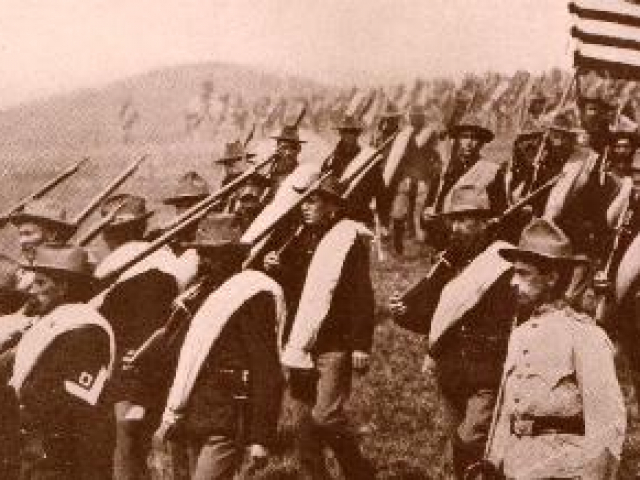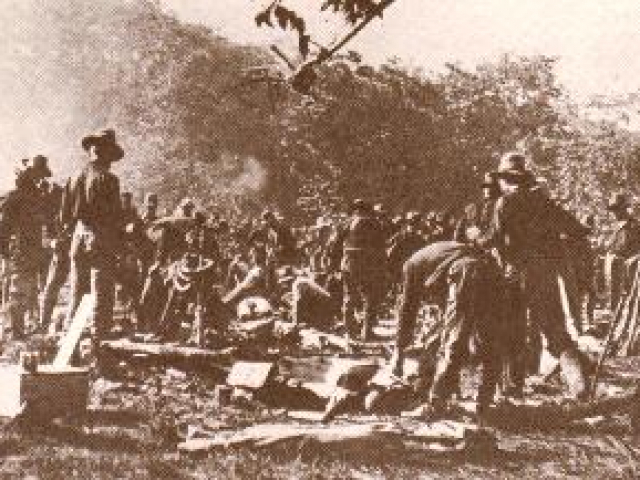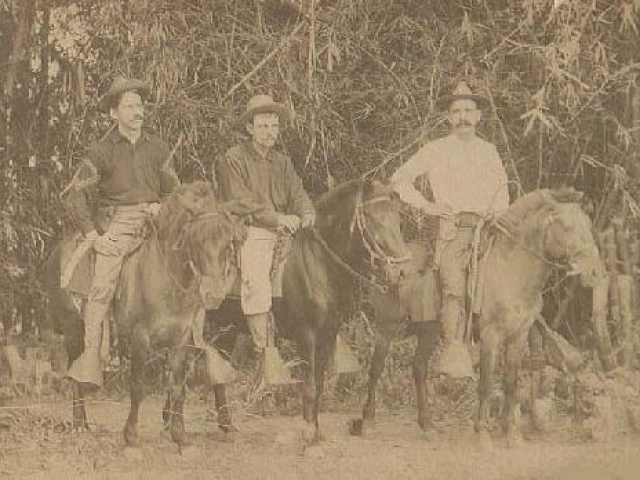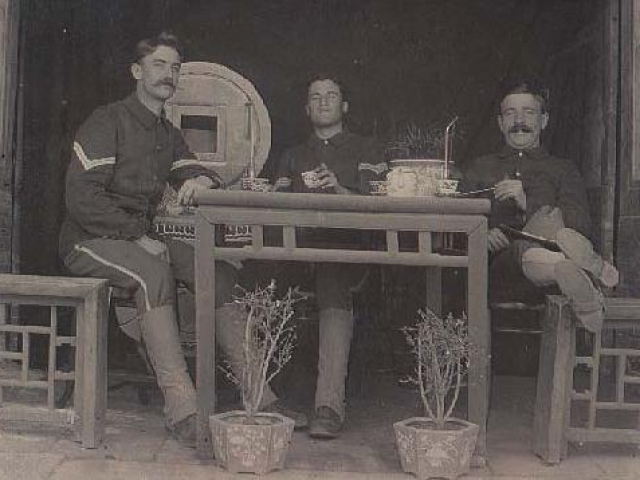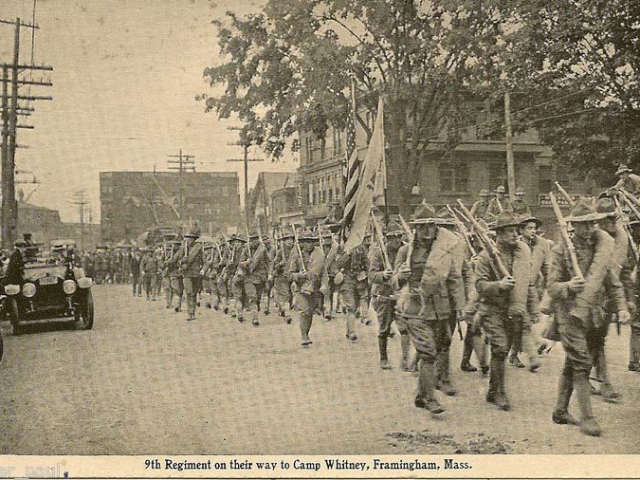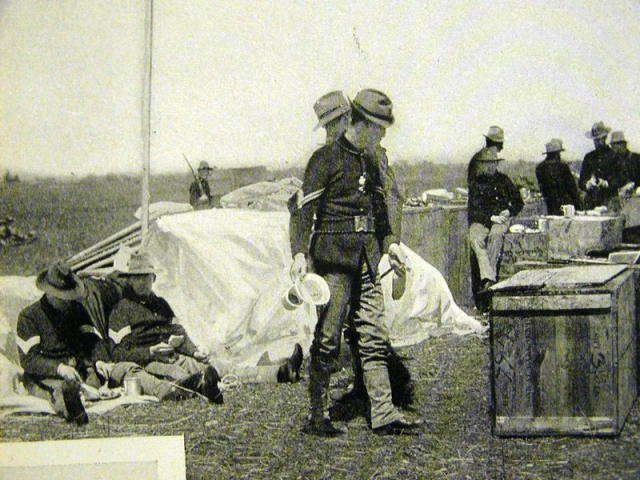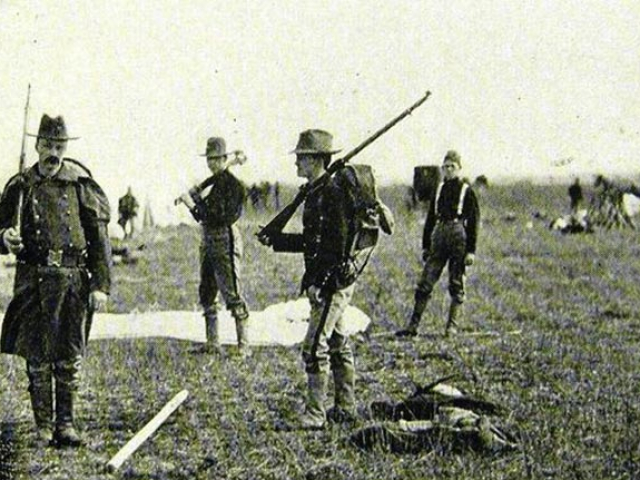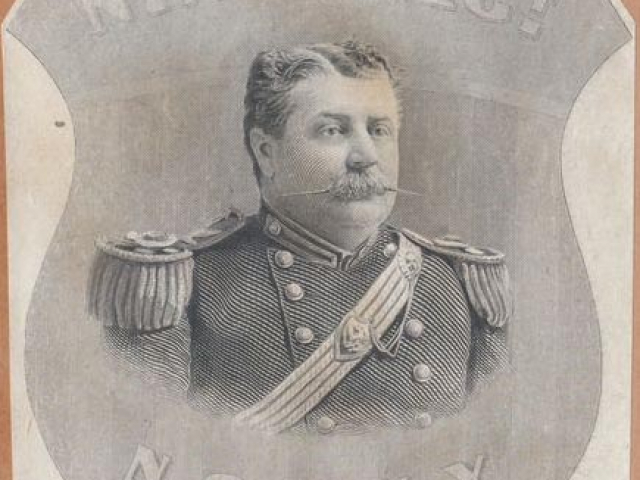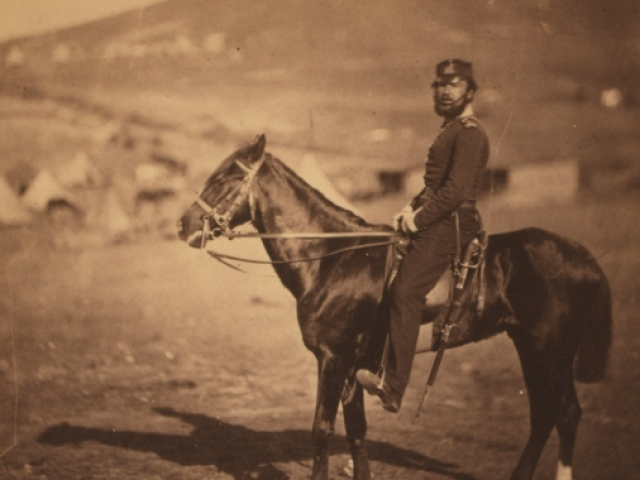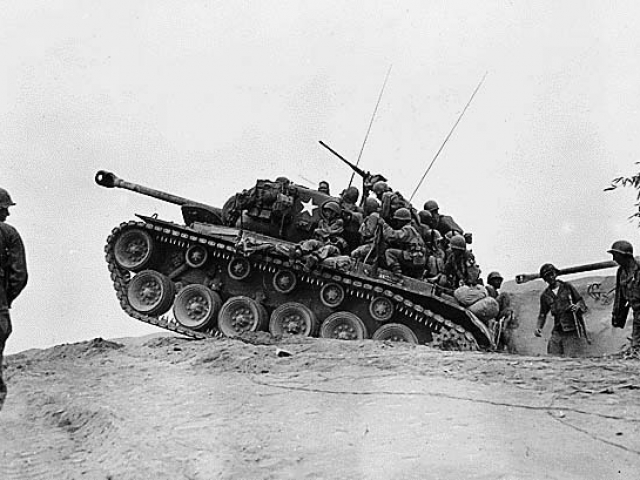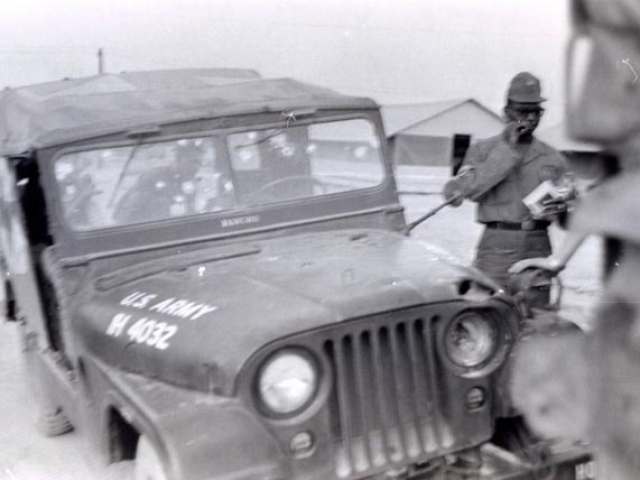History of the Regiment
The Ninth United States Infantry Regiment is one of the oldest active units in the army. The original authority permitting organization was an act of 16 July 1798 when the creation of twelve new regiments was authorized by congress. Tension had arisen between the United States and France and the creation of these additional units was deemed essential to the safety and preservation of the union.
The regiment itself came into physical existence in January 1799, in Maryland, and was composed primarily of Maryland volunteers. The Regiment's first commander is recorded as having been Lieutenant Colonel Josiah Carville Hall. In early June 1800, the Ninth Infantry was disbanded.
The Fighting Ninth was called upon to engage in the War of 1812 and was organized for the second time in March 1812, under the command of Colonel Simon Learned. The main body of the Regiment was composed of New England volunteers. In December of that year it joined the Army of the North at Burlington, Vermont and participated in engagements at York, Fort George, Sacketts Harbor, Chrystler's Field, Fort Erie and the Chippewa River. Upon termination of the hostilities, all units of the army with the numerical designation of nine and above were disbanded. The Ninth Infantry was disbanded on 13 March 1815.
By April 1847 the Mexican War had stretched existing forces to the breaking point. At that time, 32 years after it had disbanded, the Ninth Infantry began its third organization. Volunteers from Rhode Island and Massachusetts formed the nucleus of the unit. Upon arrival in Mexico, having been immediately dispatched to the center of the conflict, the Ninth was active in the battles of Padiema, Churubusco, the Valley of Mexico and the bloody battle of Chapultepec. During the battle of Chapultepec, the Regimental Commander, Colonel Truman Ransom, was killed while leading an assault upon the Citadel. During the short time remaining before the end of the war, the Regiment marched to the outskirts of Mexico City. The Ninth Infantry was disbanded for the last time in 1848.
The Ninth Infantry Regiment was officially constituted in the Regular Army on 03 March 1855. On 26 March 1855 its headquarters was established at Fort Monroe, Virginia. Immediately after this, its fourth organization, the unit was transferred to the western frontier on 15 December 1855 and began to revive the glory known to units that had previously borne that designation. The vastness of the western territory required the regiment to be decentralized. As a result, various elements of the Ninth Infantry were stationed at Fort Vancouver, Fort Steilacoom and Fort Walla Walla, all in the Washington Territory. The unit was subsequently awarded battle honors for Washington 1856 and Washington 1858.
In April 1861, the Civil War broke out and elements of the Infantry were returned from the western frontier. Its integrated elements were established as a portion of the 18'h U.S. Infantry Regiment. The actual history of the Ninth Infantry during the Civil War is hazy and the specific accomplishments are not as definite as other portions of the unit's past. Nevertheless, their effectiveness may be visualized by referring to battle honors awarded for Murfreesboro, Chickamauga, Chattanooga, Mississippi, Tennessee, Kentucky, Georgia and Atlanta.
After the Confederate forces surrendered on 09 April 1865 and the Civil War ended, the 9th Infantry was again posted to the western frontier. Intermittent service was rendered on various portions of the frontier to include Nevada, Nebraska, California, Arizona, Wyoming, Montana, Idaho, Utah, the Dakotas and Oregon. No less than 400 skirmishes were fought with numerous Indian tribes led by great war chiefs such as Geronimo, Crazy Horse and Sitting Bull. During one of these skirmishes, a small 30 man element of the Fighting Ninth was suddenly attacked by approximately 2,000 Sioux warriors near Fort Phil Kearney, Nebraska on 02 August 1867. This small band of soldiers was led by Major James Powell. Choosing to stand and fight, these soldiers hastily erected a barricade of wagon boxes, and during the entire morning stood off charge after charge. The Sioux finally withdrew, leaving behind several hundred killed and wounded. The defending forces suffered only three casualties. This action was recorded in history as the famous "Wagon Box Fight."
Elements of the Ninth also participated in the infamous Little Big Horn Campaign. Attached to the southern force under the command of General Crook, the Ninth participated in the engagement at Rose Bud Creek, and never arrived to support General Custer during his ill fated assault on the Indian village at the Little Big Horn. Elements of the ninth also participated in the famous "Starvation March" which General Crook led in pursuit of the Indian tribes which had massacred Custer and elements of the 7th Cavalry. As a result of those actions, battle honors were awarded for Wyoming and the Little Big Horn campaigns.
On 26 September 1867, Company F, Ninth Infantry Regiment was dispatched from San Francisco to Sitka, Alaska to assist in operating the newly acquired Alaska Territory. Company F arrived in Sitka on IO October 1867 and participated in the ceremony in which the sovereignty of the Alaska territory was passed from Russia to the United States. Company F remained in Alaska for approximately two years before being relieved.
In 1892, after years of activity on the western frontier, garrison duties at Madison Barracks, New York were finally awarded the battle hardened men. This respite from combat was relatively short lived though, and on 16 April 1898 the Fighting Ninth was ordered to duty in Cuba. The Ninth Infantry landed in Siboney, Cuba on 24 June 1898. During the ensuing campaign, the Ninth again distinguished itself. The Regiment earned a battle streamer for its participation in the Battle of Santiago on 01 July 1898. It was during this battle that the Regiment crossed the San Juan River at the "Bloody Angle" and participated in the assault and seizure of San Juan Hill. On 14 August 1898, after the Cuban fighting had ended, the 9th Infantry returned to the United States and resumed garrison duties at Madison Barracks, New York.
Six months later, on 28 February 1899, the Regiment was dispatched to the Philippine Islands to help quell the Philippine Insurrection. Immediately upon arrival in Manila, the Regiment moved on line. It was detailed responsibility for the elimination of insurgents on Luzon Island. After many small, fierce engagements the area was declared clear when General Macabulos, the commander of Tarlac province surrendered on 15, June 1900.
In the meantime, foreign dignitaries and missionaries (including Americans) were being subjected to the terrors of a rebellion in China. The 9th Infantry was one of only two American units chosen to protect American interests in China. After landing at Taku Bar, the Regiment began the trek towards Tientsin under the direction of the Regimental commander, Colonel Emerson H. Liscum. The assault on Tientsin began on the morning of 13 July 1900, a day that is deeply engraved in the memory of the entire Regiment. At approximately 0900 hours on that day, the Regimental Color Sergeant, Sergeant Edward Gorman, who was standing beside Colonel Liscum, was severely wounded by the intense fire. Colonel Liscum had been struck in the shoulder but he gallantly seized the Colors from the fallen sergeant, stood fearlessly holding them erect and continued-to direct the assault on the city walls in the face of murderous fire. A few moments later, the Colonel fell mortally wounded and shortly after directing his men to "Keep Up The Fire Men," he died. The regiment remained pinned down by the fierce Boxer fire for the rest of the day, and at dusk was ordered to retreat by General Dorward, the British commander of the multi-national task force. The assault was resumed the next day and the Japanese Infantry broke through the city gate and the city fell.
The Regiment participated in another engagement at Yang-Tsun and then participated in the assault on Peking. The Fighting Ninth was the first unit to break into the forbidden city and, after the fall of Peking, a sentry of the Ninth remained on guard at the entrance to the forbidden city for almost one year until the Regiment was withdrawn in mid-1901. As a result of their exemplary performance during this campaign,, the Regiment was awarded the honorary title of "Manchus," earned its foremost trophy, the Liscum Bowl, and its motto, "Keep Up The Fire."
After withdrawal from China, the Regiment was returned to the Philippines, and upon arrival in Manila in June 1901, it was assigned to Samar, to quell a rebellion. The rebel commander was Vicente Lukban (who replaced Emilio Aguinaldo who was in custody). Their duty on this island produced many encounters with the rebels. In one of these battles, seventy-four men of Company C, under the command of Captain Thomas Connell, were ambushed at the town of Balangiga. The Manchus fought fiercely and killed hundreds of natives, but of the 74 men in the company, all except four were either killed or wounded. Nevertheless, by May 1902, the island was cleared and the Regiment returned home.
Upon the entry of the United States into World War I in April 1917, the Regiment was again called to battle on foreign soil. It arrived in France in 1917 as part of the famous "Indianhead" Second Infantry Division. In early October 1917, the Manchus moved to the front. The Regiment first became involved in the then static warfare in the Sous Reuvrois Sector. When subsequently moved to Chateau-Thierry, it met and stalled the Boche Purge on Paris. Later during the involved campaign in the Meuse-Argonne Sector, and in one of the final campaigns of the war, the 9th Infantry successfully spearheaded one of the most reckless and daring moves in the history of modern warfare.
After capturing the edge of the Belval forest on the afternoon of 03 November 1918, the Regiment immediately prepared to continue the surge into the enemy lines. At 1630 hours, during an intense rainstorm and under cover of darkness, the forward movement was begun with columns on either side of the only passable road through the wooded terrain. The movement necessitated passage through the main line of enemy resistance, carried within 100 yards of artillery engaged in firing upon their recently abandoned positions. Without disturbing those units, the Regiment proceeded silently, intercepting and capturing enemy patrols and outposts, as well as defensive positions without firing a shot. At 2330 hours the movement was completed and a perimeter was established more than five miles to the rear of the defending Germans.
The German's attempt to make the Bevel Forest one of the fierce, slow defensive maneuvers was thwarted and their lines became utterly disorganized. This was one of three successful night moves or raids made by the Manchu Regiment within a period of days that aided considerably in dealing a death blow to the bewildered Germans.
After the armistice was signed on 11 November 1918, Manchu troops marched into Germany to serve as an occupation force. Occupation was terminated and the Regiment returned to the United States in July and August 1919. This was the fourth such return of the "Manchu" Regiment since the turn of the century. The Regiment was awarded battle streamers for Aisne, Meuse-Argonne, Lorraine, Ile de France, St. Mihiel and Aisne-Mame campaigns. In 1918, the Manchus were awarded the French Fourragere for gallantry during the Meuse-Argonne offensive.
During twenty-six years of peace, the longest non-combat period in its history, the first battalion was stationed at Camp Bullis, Camp Stanley and Fort Sam Houston, Texas. It was rotated among those posts until the start of World War II.
In October 1942, extensive training and winter maneuvers were begun at Camp McCoy, Wisconsin. A year later on 08 October 1943, the Regiment sailed for Ireland aboard the S.B. Anthony and arrived in Belfast, Ireland on 19 October 1943. Training became more intensive in preparation for the impending invasion of the European continent. On 07 June 1944 (D-Day +1) the Manchu Regiment set foot on the hostile soil of Omaha Beach, Normandy and immediately moved forward to capture Rubercy. Within three days they had intercepted the main rail line between Cherbourg and Paris and had driven through the Carisy Forest. After momentary reserve activity, the 9th was called forward again and captured the town of St. Germaine d' Elle. A short time later it was spearheading a three day drive south to enter Tinchebray. The 9th Infantry moved from Normandy to the Brittany peninsula on 19 August 1944. It was on this peninsula, during the Battle of Brest that some of the most courageous acts of the war are recorded. The city of Brest contained a key Fort located in a comer of the Brittany peninsula that governed a large inlet. The city was to be held at all costs. Constant pressure was maintained on the defenses by the Indianhead Division and other Allied units. On 04 September 1944, the outer defensive ring was broken, and the 9th was responsible for the capture of two of the strongholds in that defensive line.
The Manchu warriors became the first Allied force to burst into the city, and the north sector of the city surrendered to the commanding officer of the 9th Infantry Regiment.
After the capture of Brest, the 9th Infantry Regiment fought through France to the Siegfried Line in the Ardennes Forest Sector. After a bitter battle, the Regiment pierced the Siegfried Line at the Wahlersheid crossroads on 15 December 1944. That spot was later named "Heartbreak Crossroads."
When the German counteroffensive broke the Allied lines in the Ardennes Sector on 16 December 1944 (later known as the Battle of the Bulge), the 9th was withdrawn from its hard won crossroads and moved back five miles to another crossroads known as the Rocherather Baracken. It was at this crossroads that the Regiment performed one of the most outstanding defensive stands in history.
The Manchus were operating as a hinge on the "Bulge" at the Rocherather Baracken crossroads. The Manchus fought for eighteen hours against overwhelming odds, destroying seventeen German tanks, and repulsing a key drive in the German thrust. This stand enabled two battalions of the 38'h Infantry Regiment to escape encirclement, and coupled with similar stands by other allied units, caused the German counteroffensive to falter, thereby providing time to regroup and defeat this last great German effort.
After Allied lines had been re-established in January 1945, the Manchu Regiment once again spearheaded a drive through the Siegfried Line to begin a dash across Germany. The Rhine River was crossed on 21 March 1945. The Manchu Regiment then continued its drive across Germany and into Czechoslovakia to the outskirts of Pilsen where it was engaged in combat until the last days of the war. The Manchu Regiment remained in that sector on occupation duty until July 1945, when it embarked for the United States with many decorations, including three Presidential Citations.
Five years of peace were spent at Camp Shanks, New York; Camp Swift, Texas; and Fort Lewis, Washington. With the entry of the United Nations into the Korean conflict and the commitment of the Second Infantry Division to the Korean peninsula, the 9th Infantry once again readied for war. Manchu troops were the first element of the Indianhead Division to touch Korean soil when they arrived at the Korean port city of Pusan on 31 July 1950. The Manchus were immediately placed on line in defense of the Pusan Perimeter and it received its baptism of fire in the battle of the Naktong Bulge. Later they broke out from that defensive position, and began the attack Northward, when they assaulted and seized Cloverleaf and Obong-Ni Ridge on 1 August 1950. The Regiment remained there until 0 1 September when the last North Korean attempt to annihilate the Pusan Perimeter defenders shattered the Regiment, thereby causing them to retreat momentarily. The Regimental Commander, Colonel Hill, reorganized approximately 800 Manchus, and together with the 5th Marine Regiment, counterattacked and regained Cloverleaf and Obong-Ni Ridge.
The Manchu Regiment participated in the breakout from the Pusan perimeter and began the advance north with the rest of the Eighth Army towards the Yalu River. The soldiers thought that the war would be over and that they would be home for Christmas as they neared the end of their push northward. Those beliefs were crushed on 25 November 1950 though, when several Red Chinese Armies attacked the Eighth Army in the vicinity of the Chongehon River. The 9th Infantry Regiment was one of the hardest hit units and could only account for approximately one-half of its assigned members at daylight on 26 November. The 1st Battalion was overrun and the battalion commander, LTC Wolff was wounded in hand to hand combat with Chinese troops who overran them. He led a small group of soldiers out of the melee and they eventually linked up with other elements of the 9th Regiment. The heavy fighting continued for several days. The 1st Manchus were attached to the 23rd Infantry Regiment under the command of Colonel Paul Freeman. On 30 November 1950, the majority of the Manchu Regiment began to run the "Gauntlet" to Kunu-Ri with the rest of the 2nd Infantry Division. The 1st Battalion remained with the 23d Infantry Regiment to fight a rear guard action to cover the withdrawal of the rest of the 2nd Division. When Colonel Freeman received word that the Division was being annihilated running the gauntlet, he requested and received permission to withdraw along another route. He attempted to contact the 1st Manchus to order them to withdraw, but was unable to do so. Therefore, the remnants of the 1st Battalion, now under the command of Major Hinkley, were unable to comply with the withdrawal order, and the majority of those remaining battalion members are still carried as Missing In Action.
After running the gauntlet to Kunu-Ri, the remnants of the Regiment were withdrawn to an area south of the Korean capital of Seoul to refit. Manchus then spent the month of December 1950 on the monumental task of reorganizing, re-equipping, re-supplying and training, while patrolling the roads east of Seoul to Hongchon, Hoengsong and Wonju. Early January 1951 found the 9th patrolling to the northeast and northwest from defensive positions in Wonju, many times encountering enemy groups attempting to enter Wonju. The push northward by the Manchu Regiment began in early February l951,and continued until-near the middle of 1951,when they became involved in the bloody fighting that occurred along the present DMZ. In late July 1951 the Manchu Regiment participated in the capture of Hill II 79 (Taeu-San), one of the highest peaks in that area. In late August, the Manchus, under the command of LTC Gaylord M. Bishop, led the assault on the three hill mass (773, 940 and 983) which later became known as "Bloody Ridge." At the time of its capture on 5 September 1951, there were only two officers left in the three rifle companies of the 1st Battalion of the 9th Infantry Regiment.
On 18 September 1951 the Regiment was ordered to attack the ridge lines southwest of Heartbreak Ridge in an attempt to relieve pressure on the 23rd Infantry Regiment, which was attacking up the east-west spur of the ridge. After heavy fighting the Manchus secured their objective on 23 September. The North Koreans did not relinquish Heartbreak Ridge and in late September the Manchus were ordered to attack the west-side of the Mundung-Ni Valley in a final attempt to capture the ridge. The attack was successful and Heartbreak Ridge fell on 13 October 195 1.
The Regiment also participated in an engagement at Old Baldy, and on 28 December 1952 the Manchus were relieved from Pork Chop Hill and Old Baldy. On 29 January 1953 they returned to the front in the Little Gibraltar sector and conducted extensive patrolling. Special Ranger platoons, previously developed and used by each battalion while in the T-Bone battles, bore the brunt of this duty. After leaving Little Gibraltar, the Regiment moved to the sector of the line known as the Boomerang. It was located in that sector during the signing of the cease-fire pact on 27 July 1953. While the cease-fire negotiations were going on, however, a mass attack was executed by the Chinese forces on 18 July 1953, but they were again repulsed. The Regiment earned an additional Presidential Unit Citation for its gallant service in Hongchon, and the Manchus received streamers for the following campaigns while serving in Korea: UN Defensive, UN Offensive, CCF Intervention, First UN Counteroffensive, CCF Spring Offensive, UN Summer-Fall Offensive, Second Korean Winter, Korea Summer-Fall 1952 Third Korean Winter Korea, Summer 1953.
In the latter part of 1955, the Manchu Regiment was designated a gyroscoping unit within the 2nd Infantry Division. Destination: Alaska. During June 1956, advance parties of the 2nd and 71st Infantry Divisions began changing places and by 15 August 1956, the major portions of the divisions were reversed. The 9 Infantry took over the Ladd-Eielson Area, near Fairbanks, from the 4th Infantry Regiment.
During the spring of 1957, the entire Second Infantry Division began a change to the new "pentomic" type of organization. Ninth Infantry headquarters, until this time, had been at Ladd AFB. Under the pentomic reorganization, the 1st Battalion, 9th Infantry was reorganized and re-designated on 20 June 1957 as Headquarters and Headquarters Company, 1st Battle Group, 9th Infantry and moved to Eielson AFB. The rest of the 9th Infantry was distributed evenly between Ladd and Eielson Air Force Bases.
On 16 December 1957, the 2nd Infantry Division, the unit to which the 9th Regiment had been assigned since World War I, was inactivated in ceremonies at Fort Richardson, Alaska. Non-divisional support units were assigned to the Yukon command, United States Army, Alaska. The First Battle Group, 9th "Manchu" Infantry was also re-assigned to Yukon command, while its units remained split between the two Air Force Bases.
In October 1960, the units which were located at Eielson, AFB were consolidated into a solid defense force with the rest of the battle group at Ladd AFB. Two months later, the base was turned over to the Army and renamed Fort Jonathon M. Wainwright. The new home of the first battle group was established as the Army's farthest north defensive post.
Old ties were renewed less than a year later with the reactivation of the Indianhead Division at Fort Benning, Georgia. On 14 June 1960, the 2nd Battle Group was born, and the 9th Infantry was one of its integral units.
In conjunction with the reorganization of the United States Army to the ROAD concept, all Battle Groups were inactivated on I February 1963. Simultaneously, five battalions of the 9th Infantry were organized. The 1st and 2nd Battalions were organized and assigned to the 2nd Infantry Division at Fort Benning, Georgia. The 4th Battalion was organized and assigned to Fort Wainwright, Alaska. The 3rd and 5th Battalions were organized and assigned to the XI U.S. Army Corps (Reserve), with the 3rd Battalion located at Quincy, Illinois and the 5th Battalion at Danville, Illinois.
During 1963, the 1st and 2nd Battalions participated in the Army's ROTA-PLAN operation. In April 1963 the 1st Battalion relieved the 1st Battle Group, 38h Infantry in Baumholder, Germany. A week after arrival, the unit moved to Mannheim, Germany and came under the control of the 3rd Brigade, 8th Infantry Division. The 1st Battalion returned to the United States on 15 July 1963 having been relieved by the 2nd Battalion, 9th Infantry. However, with the discontinuance of the ROTA-PLAN only the colors of the 2nd Battalion returned to the 2nd Infantry Division at Fort Benning, Georgia. In exchange, the colors of the 2nd Battalion, 87th Infantry replaced those of 2nd of the 9th Infantry in Germany. The newly designated 2nd Battalion, 9th Infantry returned to Germany in January 1964 as part of "Long Thrust" for approximately 90 days.
On 14 January 1966, the 4th Battalion, 9th Infantry was relieved from assignment to the 171st Infantry Brigade and assigned to the 25th Infantry (Tropic Lightning) Division at Schofield Barracks, Hawaii. A month earlier these Manchus had been in Alaska preparing for annual winter maneuvers to be conducted in temperatures of 50 below zero. Eight weeks later the battalion was preparing for deployment to the heat and humidity of Vietnam.
April 29th saw the battalion disembark the ship General Walker at Vung Tau, Vietnam. The Manchus got a taste of what was to come almost immediately. Within hours of their arrival they found themselves under fire as their convoy made its way to the 25th Division base camp at Cu Chi. The next day, a little more than 24 hours after arriving in country, Alpha company engaged the enemy in a firefight - setting the tone of regular contact that would characterize the Manchu experience for the next four and a half years.
Many operations were conducted by company sized or smaller units but there were also notable larger scale operations in which the entire battalion took part. They included Asheville, Wahiawa, Joliet I and II, Helemano, and Kahana I and II. The following accounts are by no means definitive but illustrate the nature of the battalion's service.
On August 30, 1967, Alpha, Bravo and Delta companies were airlifted into position along a bend of the Saigon River an area that came to be known as the Horseshoe. The mission was battle damage assessment and little activity was expected but the Manchus found themselves in a fierce battle with a much larger force. It was not the first time nor was it the last for the 4th of the 9th. Three undersize rifle companies were dropped into open rice paddies in the midst of a much larger enemy force of experienced VC fighters known as the Go Mon Battalion. What had been expected to be a one or two hour minor operation turned into an all-out day-long battle during which many Manchus distinguished themselves through acts of selflessness and courage.
In mid-December of 1967, 25th Division intelligence indicated that search and destroy operations out of the Katum base had been so effective in disrupting enemy activity the NVA had decided to try to skirt the area controlled by the Manchus. Battalion Commander, Lt. Col. John Henchman was given the order to cut them off. He ordered all four line companies of the Manchus into the abandoned village of Bo Tuc to confront the large force that was trying to infiltrate the area. This force was later determined to be part of the major buildup of the Tet offensive that was to come in January. On the afternoon of December 18th the Manchus arrived at Bo Tuc and immediately began taking fire. At around 2 o'clock the next morning a regimental sized force attacked. The intense fight that ensued lasted throughout the night. Ten Manchus were killed and 35 wounded at Bo Tuc. Enemy dead were put at between 50 and 70.
On February 22, 1968 the Manchus closed the base at Katum which had served as the large forward base for the 1st BDE near the Cambodian border. After a day at Tay Ninh to prepare, the Manchus moved out to Cu Chi and eventually arrived north of Tan Son Nhut on February 25. The mission was to find and destroy rocket sites that had been used to fire on Tan Son Nhut Air Base since the Tet Offensive began nearly a month earlier. At 9:00 a.m. on March 2, 1968, the Manchus walked into what was to become one of the worst single encounter loss of life incidents in the history of the Vietnam war. Forty nine members of Charlie company were killed and 24 wounded in an ambush by a large communist force on Route 248 north and east of Tan Son Nhut near the small village of Quoi Xuan. In addition, C company suffered 24 wounded while D company suffered casualties in the fighting to reach Charlie company. Manchu Alpha, Bravo, and Delta continued operations in this area and took many more casualties until finally leaving on March 11, 1968. Rocket sites had been destroyed, and a formidable communist force had been weakened, if not destroyed. But, it had come at a great cost to the Manchus and particularly the courageous men of Charlie Company.
On December 18, 1968 the men of the 4th Battalion Manchus constructed a patrol base camp, nine and a half miles south of Tay Ninh City. It was a well fortified position so well dug in that it earned the nickname from the Manchus as Mole City. The base camp was located in an area that had been untouched by allied ground forces for over a year -- one of the most used infiltration routes in the III Corps. During the early morning hours of December 22, 1968, Mole City came under a massive ground assault by the 272d Regiment of the 9th NVA Division. The attack began shortly after midnight with a fierce mortar, 75mm recoilless rifle and RPG attack which was followed immediately by a heavy concentration of small arms and automatic weapons fire. The enemy managed to breach the defensive perimeter in several areas but the Manchu defenders held their ground and repulsed the attack inflicting serious damage to the enemy forces.
Through the actions of the Manchus and others, the concept of a patrol base on the border had been proven. It was at once an agonizing temptation to the 271st and 272nd NVA regiments on the border and a completely effective deterrent to their infiltration. On the 24th of April 1969 the Manchus established a new patrol base one and one half miles north of the "Angle's Wing" along the Cambodian border. In that flat open area, Charlie Company, with Alpha Company supporting, built a tiny new patrol base to be named "Frontier City." Shortly after midnight enemy mortars and rockets began raining down on the two companies of Manchus followed by a ground attack so heavy that the two 105mm howitzers deployed there were fired point blank into the charging NVA. The attack was repulsed. In the morning more than 200 enemy had been killed in the unsuccessful human wave attack. One Manchu had been wounded.
In the four years and six months of Service in Vietnam with the 25th Division, the 4th Battalion of the Manchus received two Presidential Citations and added 12 campaign streamers to the Regimental Colors for Combat Operations in the Republic of South Vietnam. It is estimated that 450 4th Battalion Manchus were killed in the Vietnam War. Three Manchus were posthumous recipients of the Medal of Honor, the nation's highest award for valor.
On 5 June 1972, the 4th Battalion, 9th Infantry was inactivated at Schofield Barracks, Hawaii. On 2 August 1972, the 4th Battalion was relieved from assignment to the 25th Infantry Division, and assigned to the 172nd Infantry Brigade and activated in Alaska. In January 1983, the 4th Battalion was re-designated and in April 1983, the 2nd Battalion, 17th Infantry was reflagged as the 4th Battalion, 9th Infantry as part of 1st Brigade, 7th Infantry Division, Fort Ord, California.
In 1976 the 1st Manchus were deployed into the DMZ to provide security for a focus of the infamous tree-cutting incident. This incident occurred when two U.S. soldiers were killed by the North Koreans when they were attempting to trim a tree which hindered observation of the North Korean border.
The 9th Regiment was reorganized under the Army Regimental System in April 1983 with the 1st Battalion in the 2nd Infantry Division and the 2nd and 4th Battalions in the 7th Infantry Division, Fort Ord, California. Finally, on 25 January 1985, the 3rd Battalion, 9th Infantry was activated at Fort Ord, becoming the first infantry COHORT battalion in the U.S. Army.
The First Battalion, 9th Infantry was inactivated 16 April 1987 and relieved from assignment to the 2nd Infantry Division. The 1st Battalion, 9th Infantry was reassigned on 17 May 1987 to the 7th Infantry Division and activated at Fort Ord, California. It was at this time that the Regimental Colors were brought to Fort Ord, and 1st Brigade headquarters became 9th Regimental Headquarters.
Since then, 9th Regiment has deployed to various parts of the world. 3rd Battalion served as the United States Battalion Task Force in the Multinational Forces and Observers (MFO) from 3 April to 5 October 1989. The MFO was formed as a result of the Camp David Accords and the subsequent Treaty of Peace in 1979 between Egypt and Israel. Task Force 3-9's mission was to observe and report activity in its assigned sector for possible violations of the Treaty of Peace or Protocol.
Shortly after 3-9 Infantry's deployment to the Sinai, the remainder of the Regiment was called upon by the President of the United States to deploy to Panama for Operation Nimrod Dancer. The. Ninth Infantry Regiment rapidly deployed to Panama on 1 May 1989. The purpose of the mission was threefold: first, to protect U.S. lives and property; secondly, as a show of force; and finally, to enforce the U.S.'s rights, as guaranteed under the Panama Canal Treaties. The 9th Regiment conducted show of force operations throughout the Panama Canal Area, exercising the U.S. treaty rights to their fullest until their redeployment to Fort Ord on 15 October 1989.
The Manchus remained at Fort Ord until they were, once again, called upon by the President to deploy. On 22 December 1989, the Regiment landed on Panamanian soil for the second time in less than one year; this time for combat operations. Their mission was to enter and clear Panama City of Panamanian Defense Force (PDF) members and Dignity Battalion members (armed civilians paid by President Manuel Noriega). Although the Regiment killed or captured numerous Panamanian villains, captured hundreds of weapons and a variety of explosives, and seized tons of documents, some related to drug activity, they sustained no combat losses or injuries. In late January 1990, the Regiment once again re-deployed to Fort Ord, California after successfully clearing Panama City. It was in Panama that the 9th Infantry Regiment earned its 70th Campaign streamer. Less than four months after leaving Panama, 3rd Battalion returned on an operational mission supporting Operation Promote Liberty. The mission's purpose was to support the new Panamanian government should they request assistance and to protect U.S. lives and property. The 3rd Battalion 9th Infantry returned from Panama on 3 August 1990.
Early in 1993, the 9th Infantry Regiment relocated from Fort Ord, California to Fort Lewis, Washington. In January 1995, the 9th Infantry Regiment was called upon to deploy to Guantanamo Bay, Cuba to support the humanitarian mission "Operation Sea Signal." The Manchus once again displayed their discipline and professionalism in Cuba, this time providing the security and humanitarian assistance required by over 25,000 Cuban and Haitian migrants who fled their countries.
C Co. 3/9 was sent to Panama in Dec 94 to May 95 for operation joint task force - "Safe Haven" Cuban migrant humanitarian relief to support the 92D military police battalion.
The 9th Infantry Regiment, 7th Infantry Division (Light), was re-flagged on 24 August 1995, and became the 1st Brigade, 25th Infantry Division (Light). As a result of that re-flagging action, Headquarters and Headquarters Company, and the 3rd Battalion of the 9th Infantry Regiment (Manchu) were inactivated. The 1st and 2nd Battalions, 9th Infantry Regiment (Manchu), exchanged Colors and missions with 1st Battalion 5th Infantry, and 5th Battalion, 20th Infantry, respectively. Today, those two remaining active duty Manchu battalions are once again assigned to the Korean peninsula, and as integral parts of the Second (Indianhead) Infantry Division.
In August 2004 the 1st Battalion deployed to Iraq and took control of roughly 3,500 square miles of desert -- one of the largest areas of operations in Iraq.
The 4/9 Manchus were brought back to active service when the battalion colors were were uncased at ceremonies on June 1, 2006 in Ft. Lewis, Washington as the 1st Squadron 2nd Cavalry Regiment was re-designated as the 4th Battalion of the 9th Infantry Regiment. The colors had been retired when the battalion was inactivated on December 15, 1995 at Fort Wainwright, Alaska where it had been part of the 6th Infantry Division. The re-flagging brought the battalion back to the 2nd Infantry Division with which it has served through much of its history.
Under the command of Lieutenant Colonel William Prior the Manchus then deployed to Iraq in April 2007 as the first of the elements sent to the country as part of the "surge" policy designed to restore stability to the country. After serving a bit more than a one year tour of duty they have returned to Ft Lewis. The 4/9 Manchus deployed with the Army's new Land Warrior system. In fact, the battalion served as a test bed for the new equipment.
Under the command of Lieutenant Colonel Mark Bieger the Manchus redeployed to Iraq for a second tour in 2009.
As they have done throughout their history, the 9th Regiment stands ready to respond to any global crisis in support of the United States' vital interests, and to
KEEP UP THE FIRE!
History of the Regiment Photos
Click on an image below to view full-sized version.

